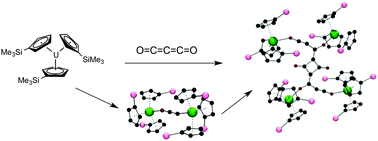Activation of carbon suboxide (C3O2) by U(iii) to form a cyclobutane-1,3-dione ring†
Abstract
The activation of C3O2 by the U(III) complex [U(η5-Cp′)3] (Cp′ = C5H4SiMe3) is described. The reaction results in the reductive coupling of three C3O2 units to form a tetranuclear complex with a central cyclobutane-1,3-dione ring, with concomitant loss of CO. Careful control of reaction conditions has allowed the trapping of an intermediate, a dimeric bridging ketene complex, which undergoes insertion of C3O2 to form the final product.

- This article is part of the themed collection: New molecules and materials from the f-block


 Please wait while we load your content...
Please wait while we load your content...